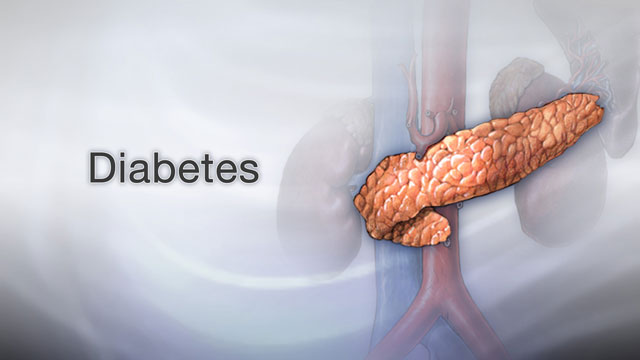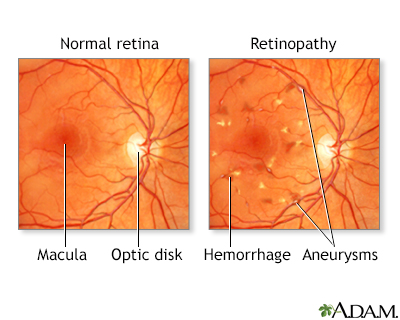Diabetes eye exams
Diabetes can harm your eyes. It can damage the small blood vessels in your retina, the back wall of your eyeball. This condition is called diabetic retinopathy.
Diabetes
Diabetes is a long-term (chronic) disease in which the body cannot regulate the amount of sugar in the blood.

Retina
The retina is the light-sensitive layer of tissue at the back of the eyeball. Images that come through the eye's lens are focused on the retina. Th...

Diabetic retinopathy
Diabetes can harm the eyes. It can damage the small blood vessels in the retina, the back part of your eye. This condition is called diabetic retin...

Diabetes also increases your risk of glaucoma, cataracts, and other eye problems.
Glaucoma
Glaucoma is a group of eye conditions that can damage the optic nerve. This nerve sends the images you see to your brain. Most often, optic nerve da...

You may not notice that your eyes are damaged until the problem is very bad. Your eye doctor (optometrist or ophthalmologist) can catch problems early if you get regular eye exams. This is very important. The early stages of diabetic retinopathy don't cause changes in vision and you won't have symptoms. Only an eye exam can detect the problem, so that steps can be taken to prevent the eye damage from getting worse.
Diabetes - Animation
Diabetes is on the rise worldwide, and is a serious, lifelong disease that can lead to heart disease, stroke, and lasting nerve, eye and foot problems. Let's talk about diabetes and the difference between the three types of diabetes. So, what exactly is diabetes and where does it come from? An organ in your body called the pancreas produces insulin, a hormone that controls the levels of your blood sugar. When you have too little insulin in your body, or when insulin doesn't work right in your body, you can have diabetes, the condition where you have abnormally high glucose or sugar levels in your blood. Normally when you eat food, glucose enters your bloodstream. Glucose is your body's source of fuel. Your pancreas makes insulin to move glucose from your bloodstream into muscle, fat, and liver cells, where your body turns it into energy. People with diabetes have too much blood sugar because their body cannot move glucose into fat, liver, and muscle cells to be changed into and stored for energy. There are three major types of diabetes. Type 1 diabetes happens when the body makes little or no insulin. It usually is diagnosed in children, teens, or young adults. But about 80% of people with diabetes have what's called Type 2 diabetes. This disease often occurs in middle adulthood, but young adults, teens, and now even children are now being diagnosed with it linked to high obesity rates. In Type 2 diabetes, your fat, liver, and muscle cells do not respond to insulin appropriately. Another type of diabetes is called gestational diabetes. It's when high blood sugar develops during pregnancy in a woman who had not had diabetes beforehand. Gestational diabetes usually goes away after the baby is born. But, still pay attention. These women are at a higher risk of type 2 diabetes over the next 5 years without a change in lifestyle. If you doctor suspects you have diabetes, you will probably have a hemoglobin A1c test. This is an average of your blood sugar levels over 3 months. You have pre-diabetes if your A1c is 5.7% to 6.4%. Anything at 6.5% or higher indicates you have diabetes. Type 2 diabetes is a wake up call to focus on diet and exercise to try to control your blood sugar and prevent problems. If you do not control your blood sugar, you could develop eye problems, have problems with sores and infections in your feet, have high blood pressure and cholesterol problems, and have kidney, heart, and problems with other essential organs. People with Type 1 diabetes need to take insulin every day, usually injected under the skin using a needle. Some people may be able to use a pump that delivers insulin to their body all the time. People with Type 2 diabetes may be able to manage their blood sugar through diet and exercise. But if not, they will need to take one or more drugs to lower their blood sugar levels. The good news is, people with any type of diabetes, who maintain good control over their blood sugar, cholesterol, and blood pressure, have a lower risk of kidney disease, eye disease, nervous system problems, heart attack, and stroke, and can live, a long and healthy life.
You Need Regular Eye Exams
Even if the health care provider who takes care of your diabetes checks your eyes, you need an eye exam every 1 to 2 years by an eye doctor who takes care of people with diabetes. An eye doctor has equipment that can check the back of your eye much better than your regular provider can.
If you have eye problems because of diabetes, you will probably see your eye doctor more often. You may need special treatment to prevent your eye problems from getting worse.
You may see two different types of eye doctors:
- An optometrist is a doctor of optometry. Optometrists provide regular eye and vision care and monitor diabetes-related eye conditions.
- An ophthalmologist is a medical doctor who is an eye specialist. Along with regular eye and vision care, an ophthalmologist treats more involved eye conditions that may require medicines or surgery.
What is a Dilated Retinal Exam?
The doctor will check your vision using a chart of random letters of different sizes. This is called the Snellen chart.
You will then be given eye drops to widen (dilate) the pupils of your eyes so that the doctor can better see the back of the eye. You may feel stinging when the drops are first placed. You may have a metallic taste in your mouth.
To see the back of your eye, the doctor looks through a special magnifying glass using a bright light. The doctor can then see areas that may be damaged by diabetes:
- Blood vessels in the front or middle parts of the eye
- The back of the eye
- The optic nerve area
Another device called a slit lamp is used to see the clear surface of the eye (cornea).
The doctor may take photos of the back of your eye to get a more detailed exam. This exam is called a digital retinal scan (or imaging). A special camera is used to take photos of your retina without dilating your eyes. The doctor then views the photos and lets you know if you need more tests or treatment.
After Your eye Exam
If you had drops to dilate your eyes, your vision will be blurred for about 6 hours. It will be harder to focus on things that are near. You should have someone drive you home.
Also, sunlight can damage your eye more easily when your pupils are dilated. Wear dark glasses or shade your eyes until the effects of the drops wear off.
Reviewed By
Sandeep K. Dhaliwal, MD, board-certified in Diabetes, Endocrinology, and Metabolism, Springfield, VA. Also reviewed by David C. Dugdale, MD, Medical Director, Brenda Conaway, Editorial Director, and the A.D.A.M. Editorial team.
American Academy of Ophthalmology website. Diabetic retinopathy PPP 2019. www.aao.org/preferred-practice-pattern/diabetic-retinopathy-ppp. Updated October 2019. Accessed July 30, 2024.
American Diabetes Association Professional Practice Committee. 12. Retinopathy, neuropathy, and foot care: standards of medical care in diabetes-2024. Diabetes Care. 2024;47(Suppl 1):S231-S243. PMID: 38078577 pubmed.ncbi.nlm.nih.gov/38078577/.
Brownlee M, Aiello LP, Sun JK, et al. Complications of diabetes mellitus. In: Melmed S, Auchus, RJ, Goldfine AB, Koenig RJ, Kopp PA, eds. Williams Textbook of Endocrinology. 15th ed. Philadelphia, PA: Elsevier; 2025:chap 38.
Skugor M. Diabetes mellitus. In: Sadda SVR, Saraff D, Freund KB, et al, eds. Ryan's Retina. 7th ed. Philadelphia, PA: Elsevier; 2023:chap 48.



 All rights reserved.
All rights reserved.